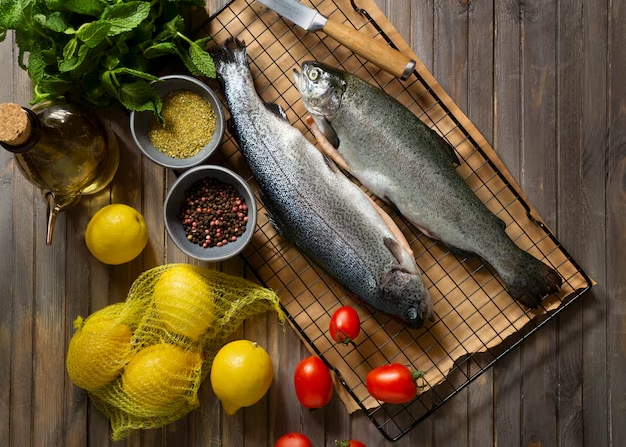How Long Can You Store Fish in Your Fridge Before It's Unsafe?
When it comes to storing fish, understanding shelf life is crucial for both health and culinary delight. Whether you're a seafood aficionado or simply enjoy the occasional fillet, knowing how long fish can be safely stored in the refrigerator is an essential skill. This guide delves into the details surrounding fish storage, providing clarity and practical advice to ensure your fish remains safe and fresh for consumption.
🐟 The Basics of Fish Storage: How Long is Too Long?
Fish is a protein-rich food that's both nutritious and delicious, but it's also highly perishable. Keeping fish fresh involves understanding the balance between time and temperature. Fresh fish can typically be stored in the refrigerator for up to two days, but there are several factors that can influence this timeframe.
Factors Influencing Fish Shelf Life
- Type of Fish: Oily fish like salmon and mackerel tend to spoil faster than lean fish such as cod or haddock. The fat content can accelerate deterioration.
- Freshness at Purchase: The shelf life of fish largely depends on how fresh it was when you bought it. Fish that's already a few days old when purchased will spoil more quickly.
- Refrigeration Temperature: Consistent refrigeration at temperatures below 40°F (4°C) is crucial. Keeping fish stored at this temperature slows bacterial growth.
- Packaging: How fish is wrapped can also affect its longevity. Airtight packaging can help maintain freshness.
Signs Your Fish Has Gone Bad
Recognizing spoilage is critical for food safety. Key indicators include:
- Smell: Fresh fish should smell mild, not fishy, sour, or ammonia-like.
- Texture: The flesh should be firm to the touch. If it's slimy or mushy, it's time to discard it.
- Color: Look for any discoloration, such as brown or gray streaks, indicating spoilage.
🧊 Storing Fish in the Fridge: Tips for Maximum Freshness
To extend the shelf life of fish in the refrigerator, consider these best practices:
Proper Storage Techniques
- Wrap It Right: Use moisture-proof, airtight containers or tightly wrap the fish in plastic wrap, foil, or butcher paper to prevent exposure to air.
- Placement: Store fish in the coldest part of the fridge, typically the back or bottom shelf.
- Ice It Down: Placing a tray of crushed ice under the fish can help maintain a consistent chill, mimicking a fish market setup.
Practical Tips for Safely Enjoying Fresh Fish
- First-In, First-Out: Organize your fridge to use older items first.
- Regular Checks: Make it a habit to check fish for freshness daily, even within the two-day window.
- Freezing: If you’re unable to consume your fish within the recommended timeframe, consider freezing it (discussed further below).
🧊 Freezing Fish: Extending Shelf Life Beyond Refrigeration
How to Freeze Fish Properly
Freezing fish is a great way to preserve its quality for extended periods. Here's how to do it right:
- Pre-Freeze Prep: Clean and dry the fish before freezing to prevent ice crystals.
- Packaging: Use vacuum-sealed bags or heavy-duty freezer bags. Remove as much air as possible before sealing.
- Labeling: Always label your package with the date. Most fish can be frozen for up to six months.
Thawing Fish Safely
Safe thawing ensures that your fish maintains its quality and food safety:
- Refrigerator Thaw: This is the safest method. Plan for a full day of thawing for most fish.
- Cold Water Thaw: For quicker thawing, use a sealed bag in cold water. Change the water every 30 minutes.
🍣 Different Fish, Different Timeframes: A Quick Reference Guide
Here's a summary table of how long different types of fish can typically be stored in the refrigerator:
| Fish Type | Fridge Shelf Life | Freezer Shelf Life |
|---|---|---|
| Salmon | 1-2 days | Up to 3 months |
| Cod | 2 days | Up to 6 months |
| Haddock | 2 days | Up to 6 months |
| Mackerel | 1-2 days | Up to 3 months |
| Tuna | 1-2 days | Up to 3 months |
😋 Making the Most of Your Fish: Culinary Tips
When you have fresh fish, making the most of its flavor profile is key. Here are some culinary suggestions that celebrate the freshness of fish:
Cooking Methods to Highlight Freshness
- Grilling: Ideal for fatty fish like salmon, which benefits from the high heat and smoky flavor.
- Baking: A gentle method that preserves the delicate textures of lean fish like cod.
- Searing: Best for tuna steaks, which can be served rare in the center for a melt-in-your-mouth experience.
Pairing and Serving Suggestions
- Citrus and Herbs: Brighten flavors with lemon or lime and aromatic herbs like dill or parsley.
- Simple Sauces: A light beurre blanc or olive oil drizzle can enhance without overpowering the natural fish taste.
📝 Quick Tips Recap: Keep This Handy!
Here's a quick and concise bullet list of best practices and insights for storing fish:
- 🧊 Refrigerate: Keep fish cold and consume within 1-2 days.
- 📦 Packaging: Use airtight containers or wrap tightly.
- 🧼 Smell Test: Discard fish with a strong or unpleasant odor.
- ❄️ Freeze Early: Freeze if not consuming soon after purchase.
- 🍣 Use Freshness: Organize to eat older items first, retaining quality.
By following these guidelines, you can safely enjoy fish while maximizing its taste and nutritional benefits. Fish doesn't just nourish the body, but it also tantalizes the taste buds. By understanding how to store it appropriately, you can enjoy delightful dishes while maintaining peace of mind about food safety.
Remember, enjoying fresh fish begins with proper storage, so keep these tips handy and savor the flavors of the sea with confidence!
